Tutorial 5: Write Personalised Outreach Messages for your Prospects

What are the best practices for LinkedIn cold outreach messages?
First, some Mythbusting
If you've done some reading on LinkedIn cold outreach, you may have come across a few opinions about how best to do it.
We've been running campaigns for a number of years now, and have tested various hypotheses in the campaigns we have run.
Here are some of the important things we've learned:
- Hypothesis one: blank connection requests perform better than personalised connection requests.
- Every personalised campaign we've ever run has performed better than the blank campaign we ran in parallel.
- But more importantly, the 'personalisation' people are talking about when they say this is generally just dynamic keyword personalisation. Not the kind of personalisation we advocate in this tutorial.
- Hypothesis two: campaign execution (message send) automation tools do personalisation.
- As above, the important distinction is the difference between dynamic keyword personlisation and full personalisation.
- All campaign automation tools offer dynamic keyword personalisation, like basic name and company placeholders.
- Many campaign automation tools offer the ability to load custom text - and it's this feature that allows you to load your own fully personalised messages. But the onus is on you to produce those fully personalised messages.
- Hypothesis three: personalisation is always good.
- Personalisation can actually be bad. Here are some examples:
- Paying strong compliments to your prospect can come across as awkward. Things like "I'm so impressed by your recent comment" or "what you're doing with your team is really fascinating" can set the wrong tone for a new prospect relationship in which there should be an element of negotiating power on both sides.
- Referencing something entirely irrelevant to your proposition before clarifying why you want to talk can come across as disjointed, unrefined and it can even create false implications. For example, "Love that you volunteer at the foodbank! I'd love to tell you more about my recruitment service."
- Picking up on something relatively generic like "we are alumni of the same school/university/company" - can be too vague or removed if it is not related to your proposition. It's a weak reason to connect by comparison to other personalisation options.
- Personalisation can actually be bad. Here are some examples:
So let's talk about what does work.
Which messages should be sent to each prospect?
There is a best practice formula to LinkedIn outreach, and it involves sending multiple well-personalised messages to each prospect.
How many messages per prospect?
Sending repeated messages before receiving a response is an effective professional strategy to maximise the probability that a prospect will respond. Very often, prospects receive a message they genuinely intend to reply to, but it's at the wrong moment in time and then they forget.
So sending another message is a great way to remind them to reply.
But it's important to get the balance between 'helpful reminders' and 'so frequent it's a little annoying'.
The sweet spot for a LinkedIn outreach campaign is 4 messages, including the initial connection request message.
Why is that less than you'd send on email?
DMs on LinkedIn should be used in a more circumspect way than email - because they are by nature 1:1. Emails are often sent in bulk for generic reasons, and expectations are already in place for this.
But DMs are, and should remain, much more personal. And in that context, the messages need to be harder-hitting, and less multiplied.
So for every prospect in your LinkedIn campaign, you have 4 attempts to prompt a response, and each attempt matters.
The first message is the connection request message, where the character count is limited by design. The last is a 'last message for now' message, and should be intentionally a glance-read. So the middle two messages, being longer, are your main chance to share engaging content to provoke interest.
Here is the best practice message formula we'll now walk through:
- The connection request message
- An initial followup message
- One material share message
- One 'last message for now' message
What should each message say - and should they all be personalised?
One benefit of using LinkedIn DMs for cold outreach is that LinkedIn profiles provide lots of context about you and what you do - meaning that you don't have to explain so much in your outreach message.
For that reason, and also because of the size of LinkedIn's user interface for messaging, the best LinkedIn DMs are usually shorter than emails.
That's both a curse and a gift - you have fewer words to make an impact, but you are encouraged to be much more concise and pertinent with what you say.
And the more concise and pertinent you can be, the easier it is for your prospect to read, engage and respond.
So what should you say in each of your 4 messages to have the greatest chance of a response?
-
The connection request message
-
The most persuasive connection requests come with an obvious reason to connect. Why should this person open up their profile and activities to you for the rest of time? Why would they want to see your activities in their feed, in the future? Have a look at these connection requests - why would you accept them, especially if you're senior and/or you receive these all week every week?
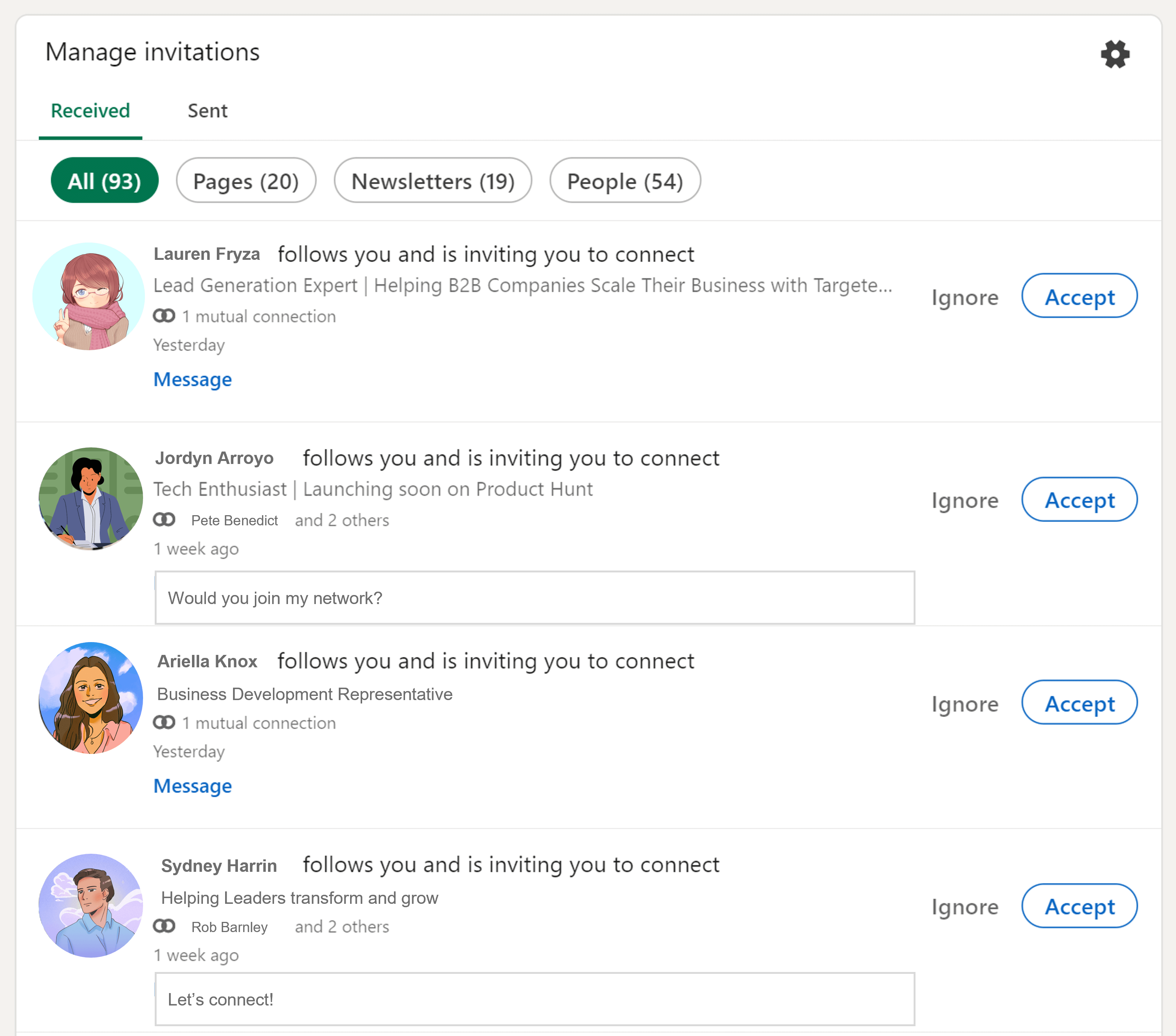
-
Your request will do best if it catches their eye by saying something personal about them that shows you noticed them for a relevant reason. A reason that you both could be mutually interested in.
-
If you can find a recent comment, article, contribution or post they shared on LinkedIn that is directly relevant to your proposition and the outcomes it supports, then reference it - it's a great reason to have 'stumbled across' their profile with interest.
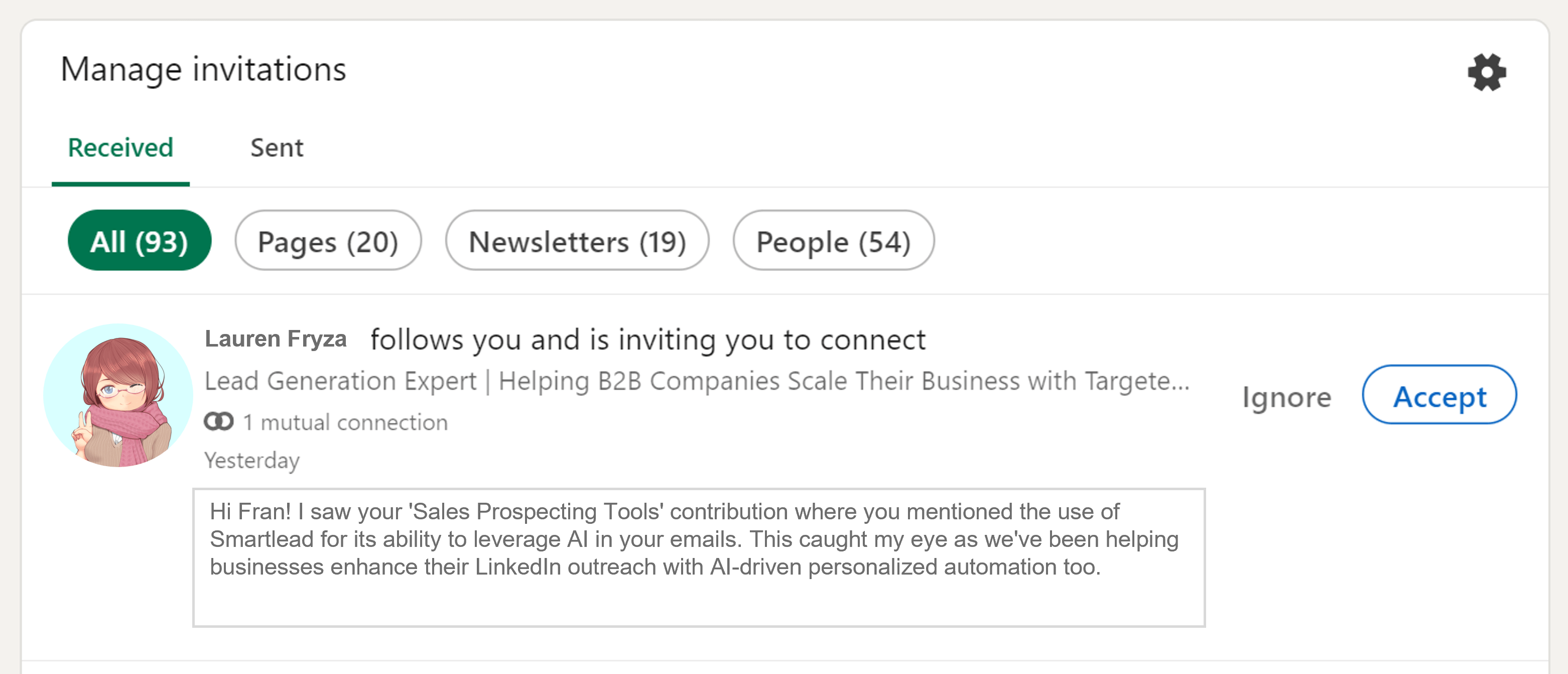
-
However, more often than not, any recent activity will not be directly relevant to your proposition, and so any reference to it can sound more like a weak excuse to reach out.
-
Instead, if they are the right prospect, you will always be able to find something relevant to say about what they do in their work, or more likely, what their company does in its work.
-
Pick the single most relevant thing about this work, and reference it. Prioritise something that is niche or harder to find out about - the more niche, the more eye-catching the message will be, because it shows real research and real interest. For example, 'connecting with ideal clients' is terminology this prospect's company uses.
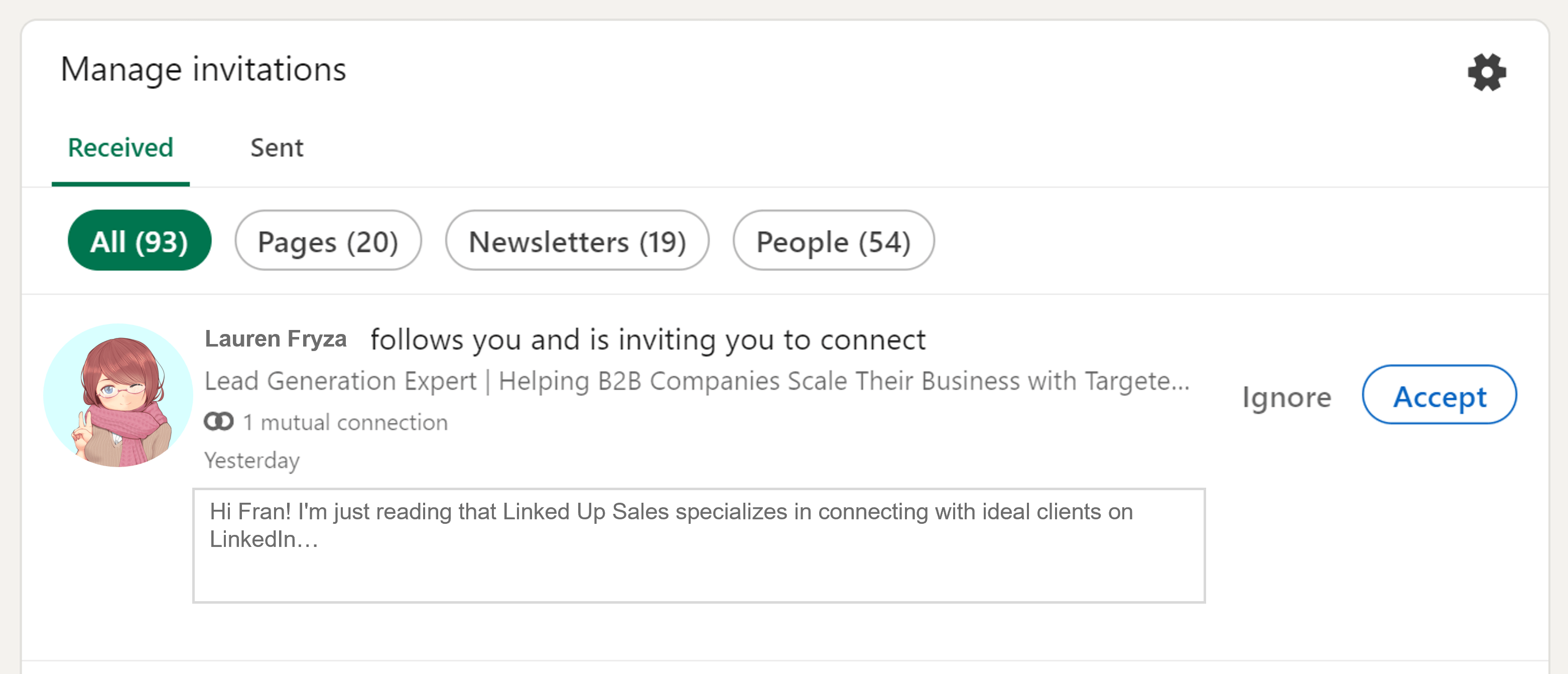
-
Even better, if you can also find the space within your 300 character limit to explain why you're interested, then do. Doing this leads the conversation in the direction you want, much faster.
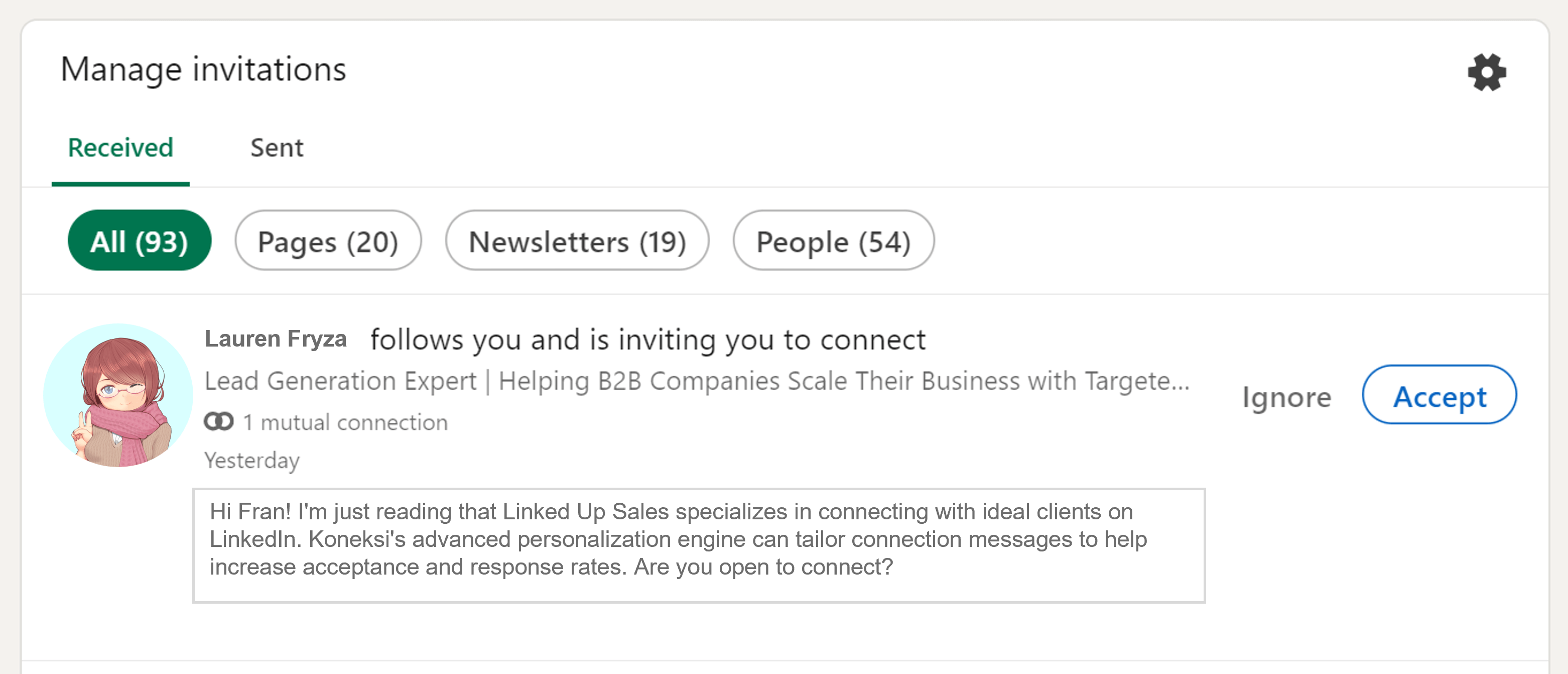
-
If you don't reference why you're interested, sometimes responses offer to tell you more about the thing you've referenced, and it can take you longer to manouevre the conversation to exploring what you can offer them instead. You may prefer that gentler approach - and your personal preference here should play its part.
-
-
The follow-up message
Once your prospect has accepted the invite, it's time to send another message.
-
First, thank them for the connection. This helps immediately to delineate your message from any cold inMails by signalling that your message is more relevant. The prospect already made a decision to connect with you, so replying to you is one step less removed.
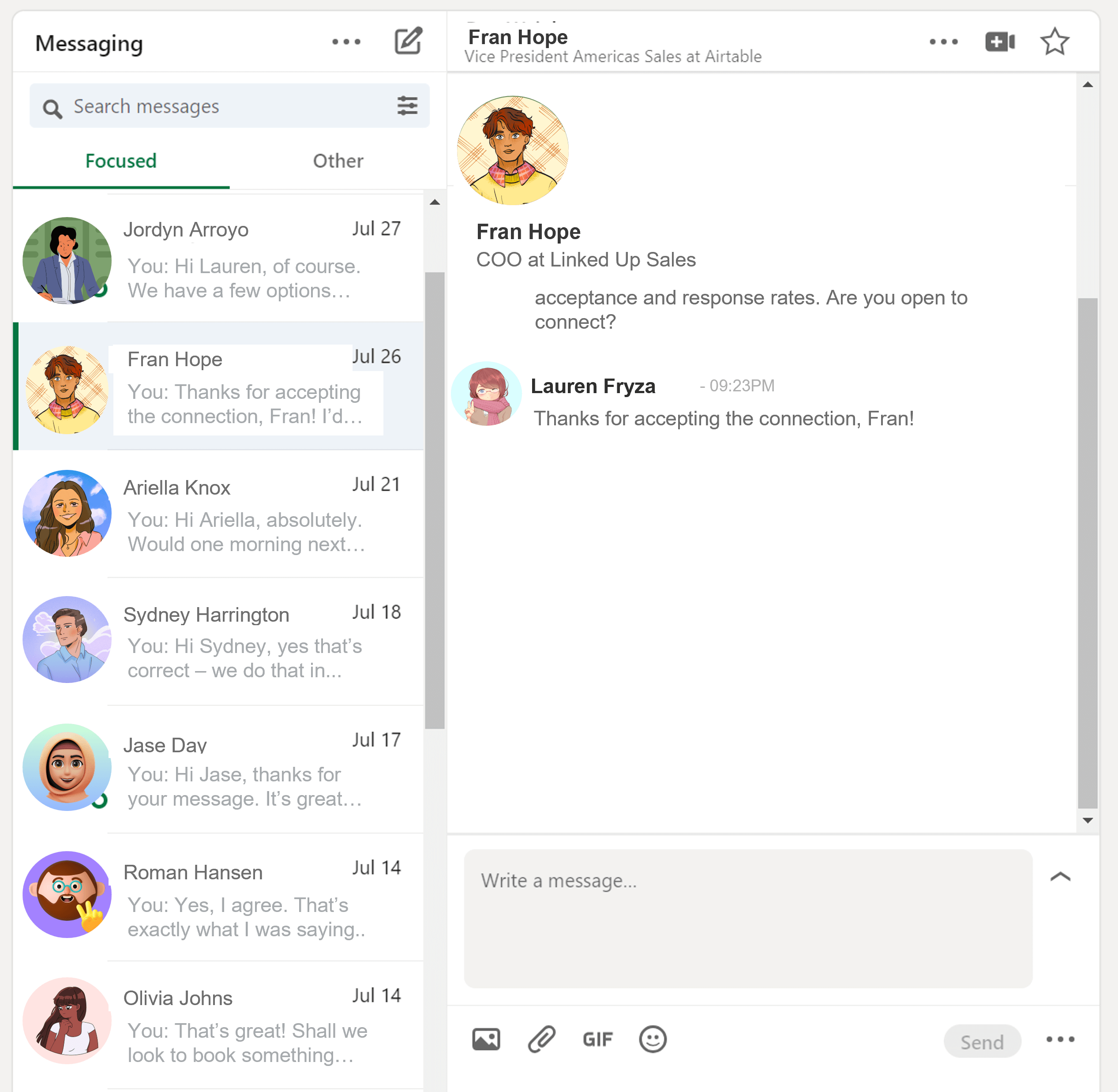
-
Next, the message needs to expand on what you said in your connection request. You have more space in this message to say a bit more about what you noticed they do. The more nuanced and niche you can be here, the better. Impress them with what you know! Use their specific terminology if you can.
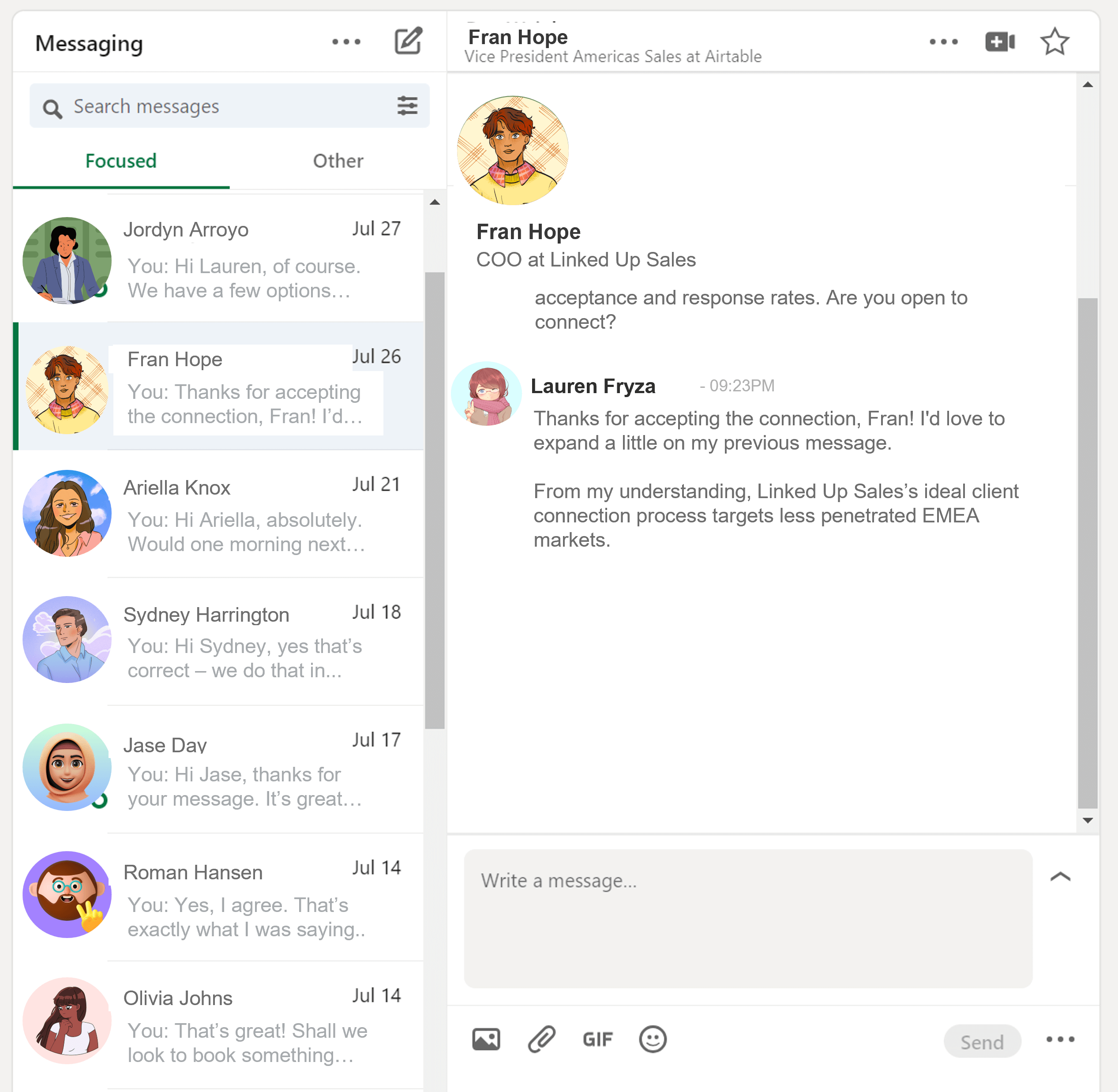
-
Last, you have the option to include a reference to pain points that you know similar people or similar companies have experienced. Making this reference often resonates with emotional triggers that lead faster to purchase decisions. Make sure you reference the pain point that is most likely to be relevant for this specific prospect. If it's not relevant, the prospect will switch off because they have no current reason to buy.
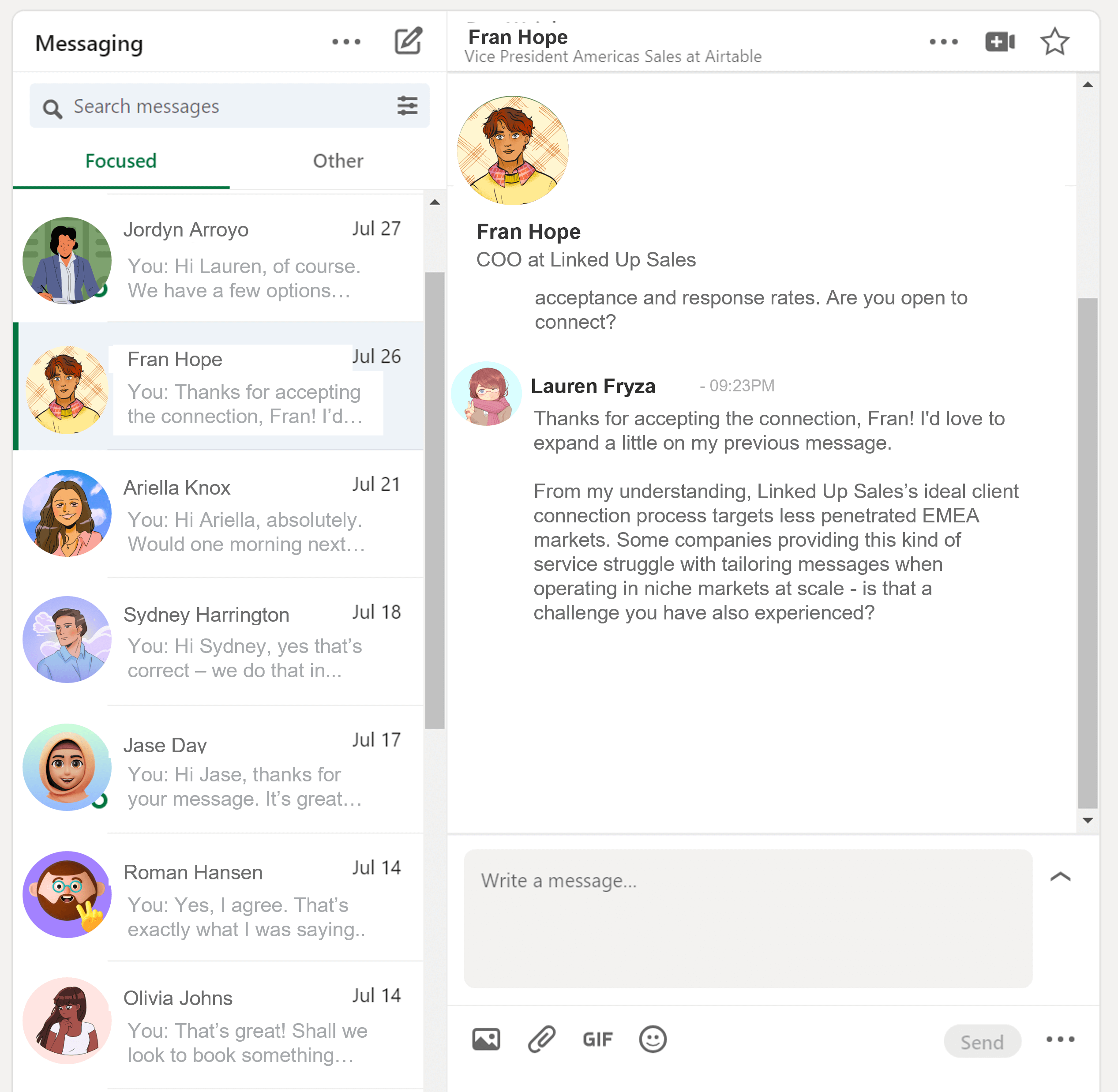
-
Use this opportunity to add more colour about what you do and why they might be interested. Keep it simple, use basic language, and if you've referenced pains, explain how those pains are solved, and/or what outcomes can be achieved. The prospect shouldn't have to do any brainwork at all to understand your proposition. Make the barrier to entry as low as humanly possible.
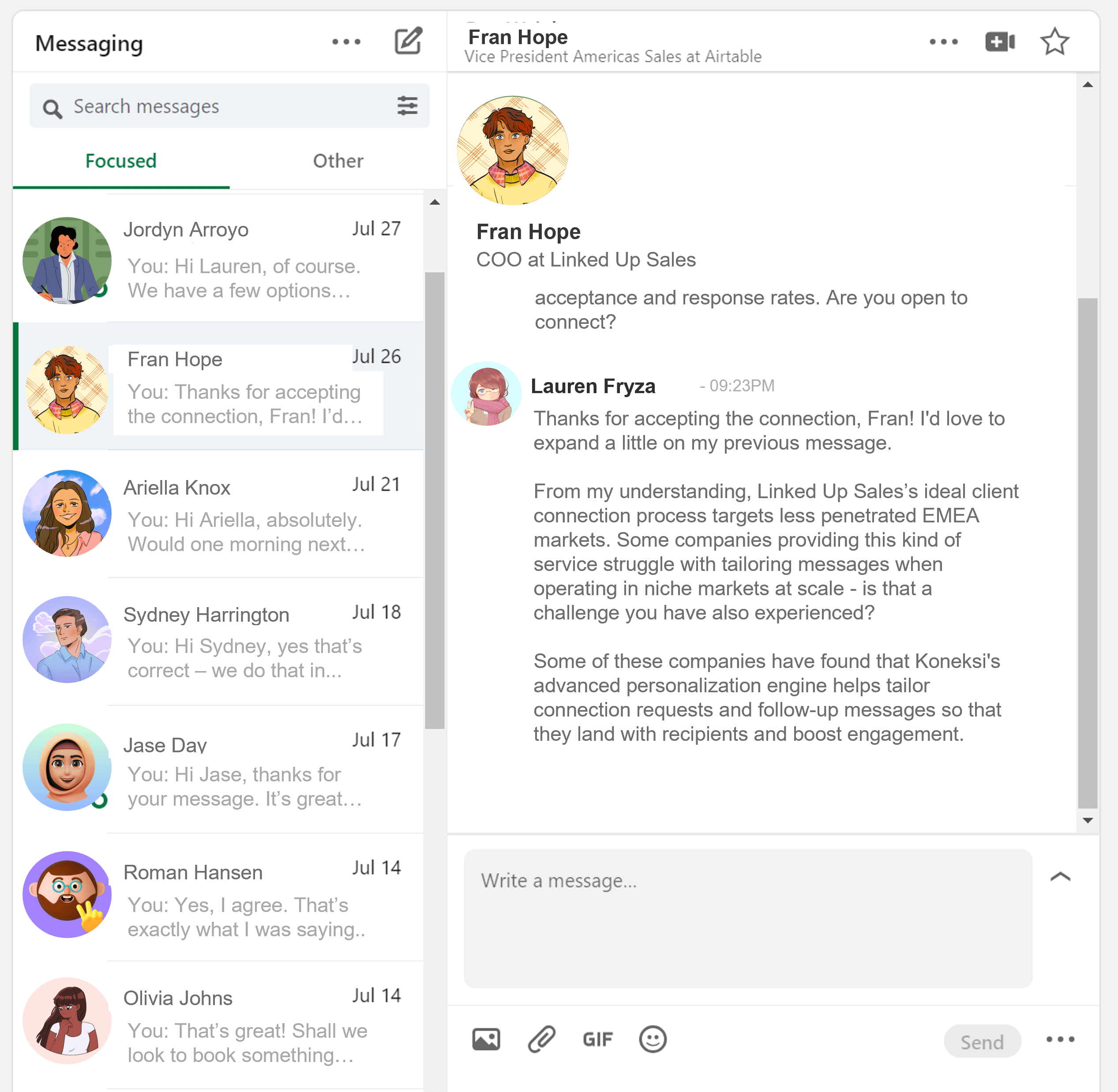
-
As a final note, always propose a next step - either suggest a meeting or ask if you can send over some interesting material. You're going to share some material anyway, so rather than asking permission to do that, asking for a meeting at this point is a good approach. If you don't feel comfortable doing that in this message, then asking to share some material can be a gentler approach - and still gives you the opportunity to ask for a response.
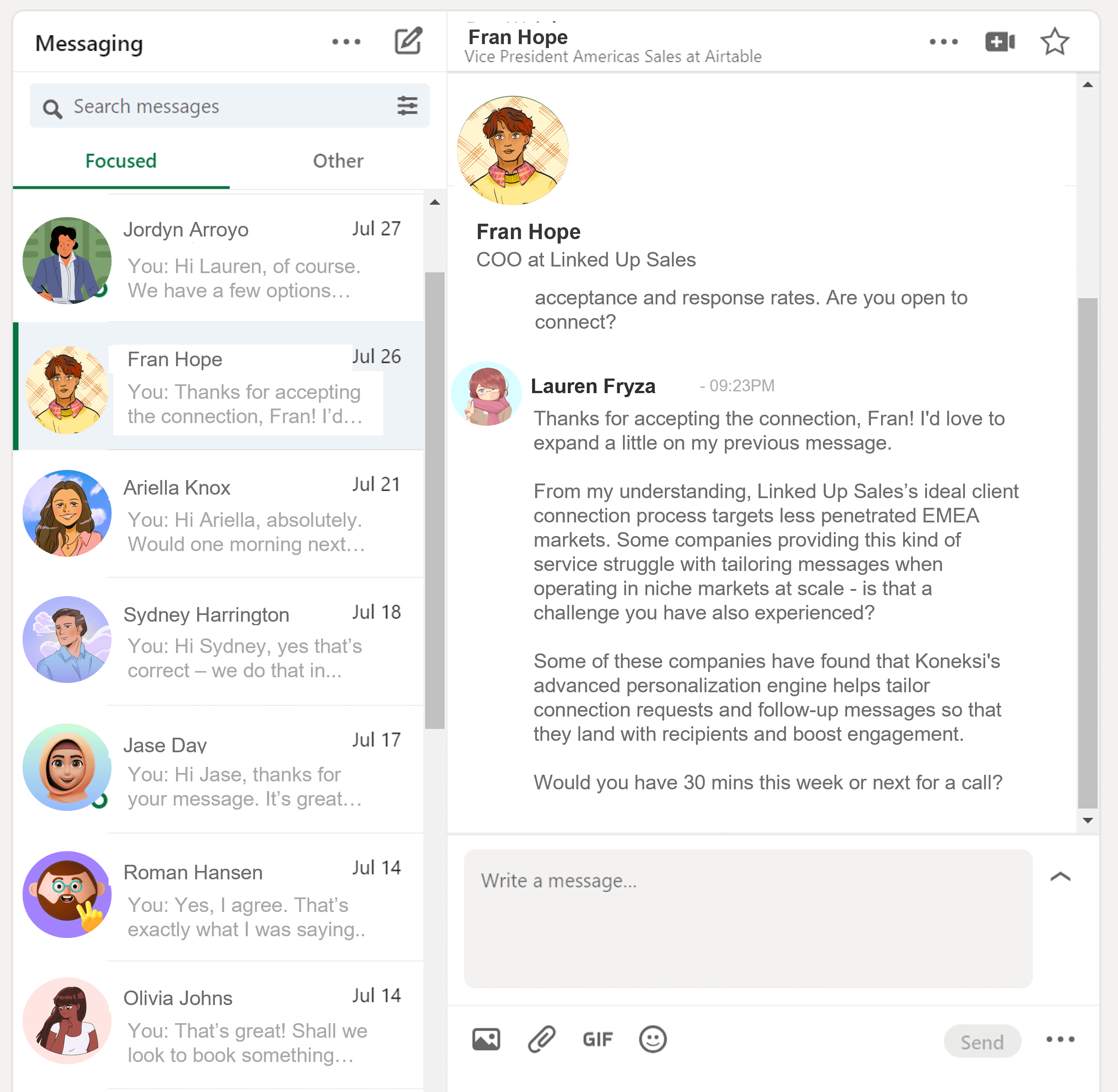
-
-
The share material message
Let's say your prospect still hasn't replied. So it's time to send another message, this time with some targeted public content.
-
Your goal is not to initiate a lot of conversations about specific content with your prospects, because that can be very time consuming for you. (Although it is a long term sales strategy!)
-
Instead, having relevant and quality content to share provides a great excuse to remind your prospects about responding to you. Sometimes they really have just forgotten to reply. It also helps establish your credibility with the prospect.
-
At the very least, if your material is relevant to your prospect, you are being helpful in sharing something useful with them. Explaining why the material is relevant for them, or relevant for what you've been talking about with them, is a great way to keep the conversation personal and engaging. The more relevant you can be, the higher the probability of a response.
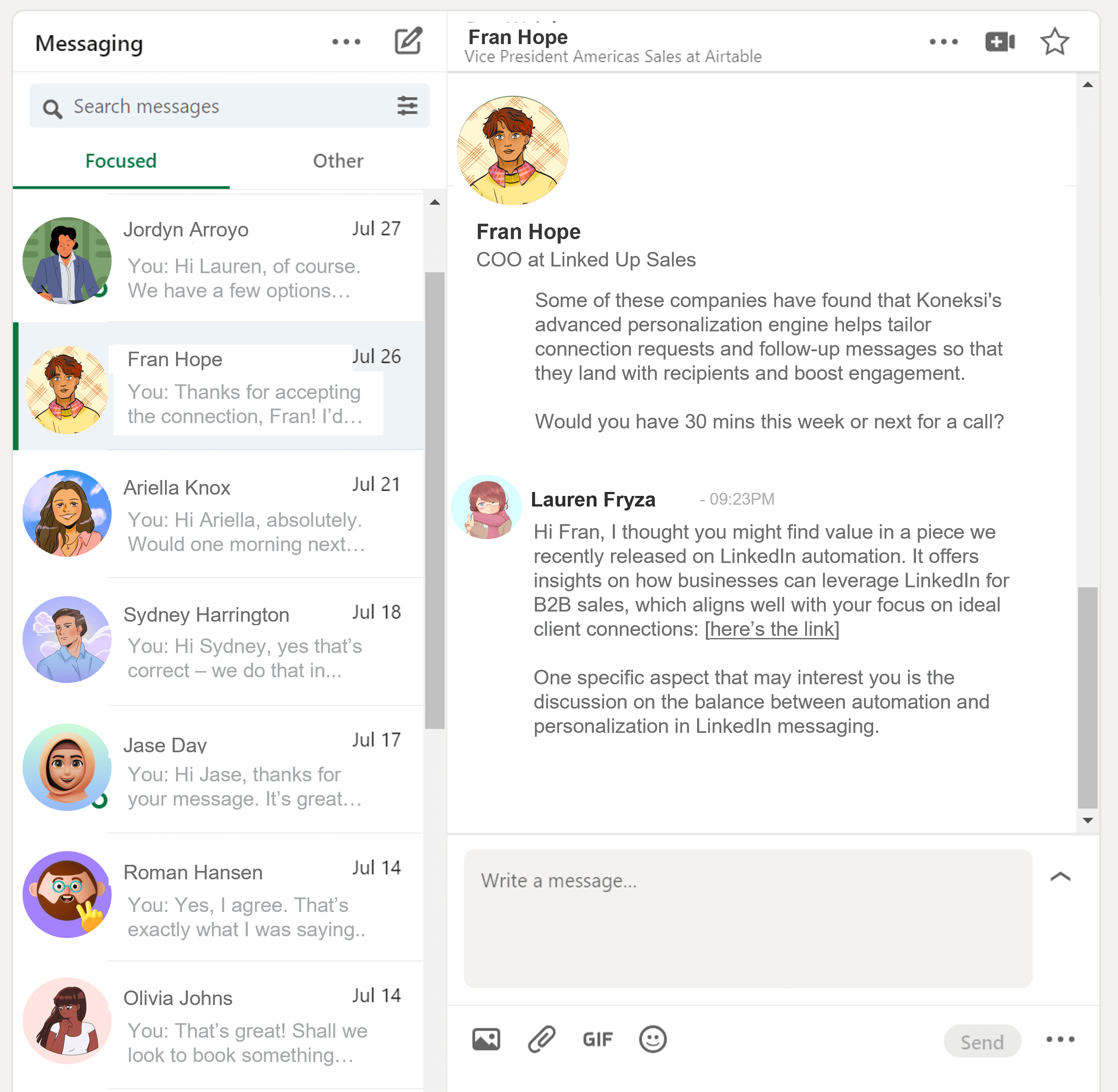
-
Again, finish by proposing a next step - suggest a meeting or mention an invite to something relevant.
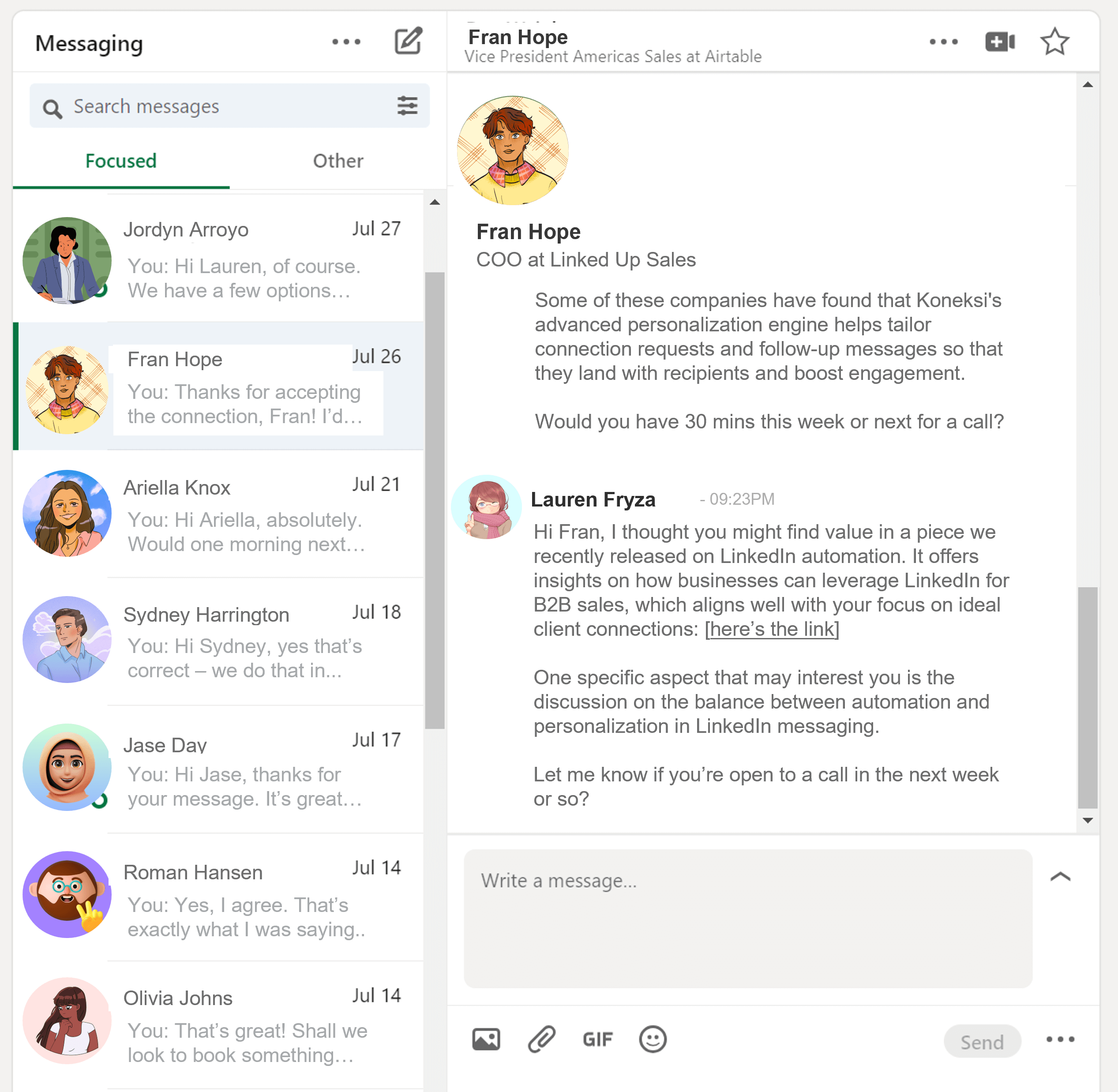
-
-
The 'last message for now' message
-
Other than using their first name, this message doesn't need to be personalised. You can send this blanket message to prospects with dynamic keywords only.
-
The purpose is to send a final prompt to reply before promising to pause outreach for some time. It's a considerate way to remind them about your messages whilst acknowledging and respecting their privacy/personal space, and it's a great way to create urgency to respond before giving them some extended time.
-
Ask if there's a good time for you to reach back out in the future - this gives the recipient an opportunity to tell you at what point they'll need your product/service, if it's not right now.
-
State when you'll reach back out if you don't hear back from them.
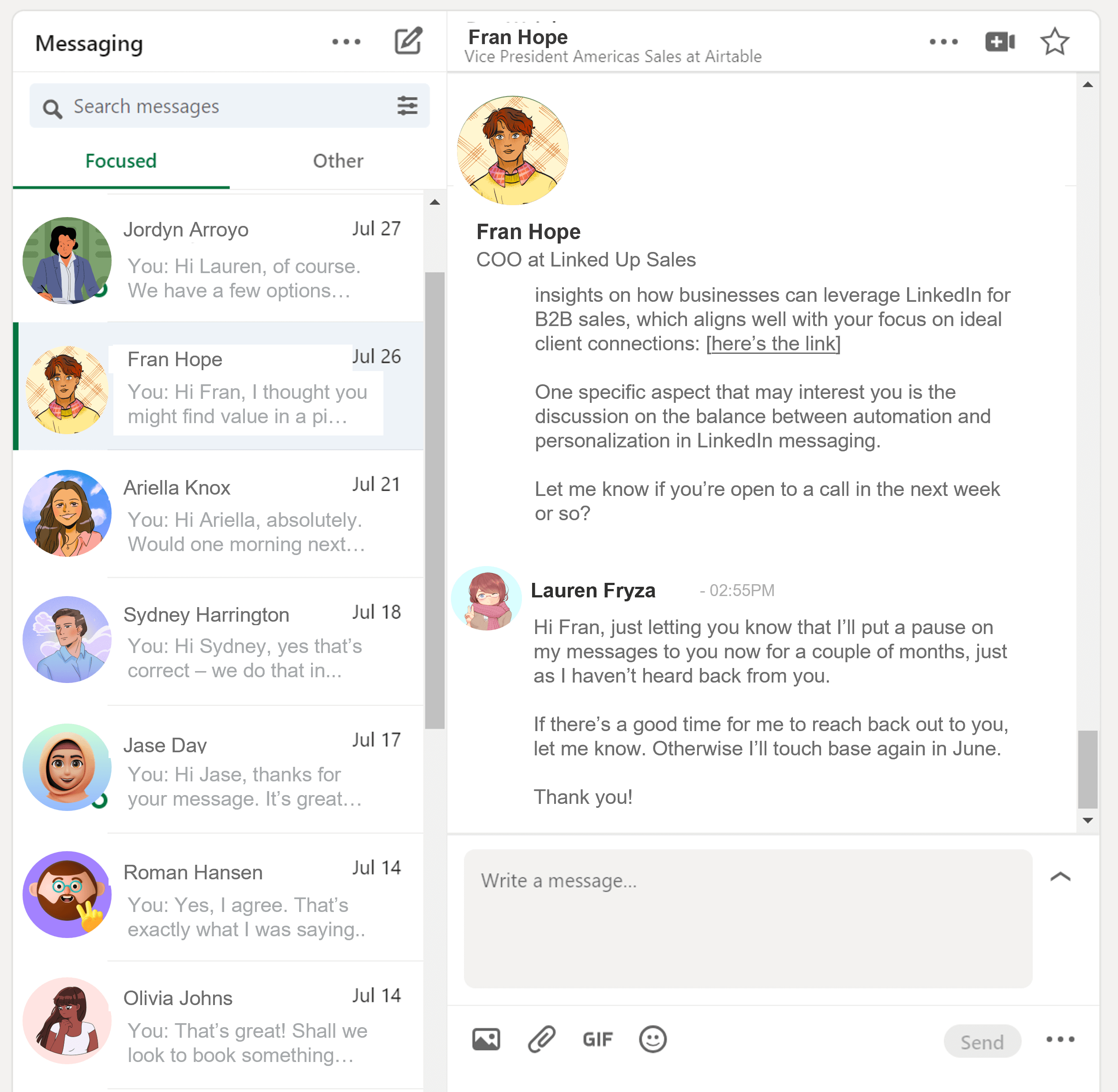
-
At what point in time should each message be sent?
Your timeline starts when you send the initial connection request message. Requests are typically accepted anywhere between immediately and several weeks. The bulk of acceptances should happen within 1-2 weeks.
Once the connection request is accepted, send the follow-up after 1-4 hours, so that your name and first message is in recent memory. The more your prospect recognises your name and remembers your message chain, the more likely they will read your next message (the follow-up message).

If there is no response to your follow-up message, wait 1 week and then send the material share message.

If there is no response to the material share message, wait 1 more week and then send the pause message.

You'll need to make a note of the date you have suggested you'll follow up, and ensure you take up this opportunity to follow up at that point.
Following up at that point can be done via a second campaign - which sends messages to all prospects that never responded to the first campaign.

Ultimately, the aim of the game is to maintain regular contact with all prospects so as to be top of mind at the point that a need and purchase decision materialises for each and every prospect.
What's the best way to scale this message-writing process for tens, hundreds or even thousands of prospects?
Researching tens, hundreds or thousands of prospects gets very cumbersome very fast. And it's not possible to personalise messages properly without doing that research.
There are a couple of options that help to scale this process (outside of hiring more people into your team):
Outsourcing to an Offshore Service via Upwork or Fiverr
- A cheaper option than hiring people into your team is to stand up some offshore external services that can scale up and down as you need.
- This maintains the human element to your research and message writing process, and it is usually much cheaper than hiring internal FTE.
- However, it will take time to ramp up these resources and ensure they are following the process you need. This will not be a one-off ramp up process either, as resources will often need to be swapped in or out. So you'll need a management process in place.
- You'll also need to put in place a quality review process to assure that the messages have the quality of writing and research that you expect. This adds further management overhead on your side.
Using Koneksi's personalised message generation engine
- Often the easiest way to scale a process is by automating it. And that's exactly what Koneksi does.
- Koneksi's message generation engine researches your prospects and produces exactly the messages as outlined above.
- If you buy a subscription with us, you can generate messages on demand, for as many prospects as you need.
- Or if you'd like to step away from the whole process of generating messages, you can buy a Done For You product from Koneksi and we'll generate all of the messages for you - sending them to you in a csv to load into your campaign.
- Note that we also provide a full service option - to source prospects, generate messages and send those messages in a campaign from your profile.
- Whatever level of involvement works best for you, works for us.
For more inspiration on how to write outreach messages (or how NOT to write outreach messages!), you can also check out the following:
- We're about to release a couple of Message Walls - where we showcase lots of examples of good and bad messages. Stay tuned!
- Here's a great blog on what to write in an cold outreach email (it's different to LinkedIn, but it's great food for thought): https://skylead.io/blog/cold-outreach/


